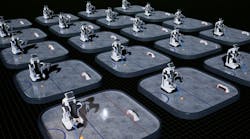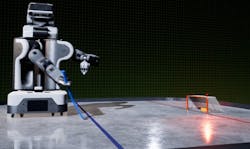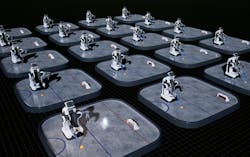In his keynote address at Computex, Nvidia CEO Jensen Huang announced the company’s Isaac Initiative (Fig. 1), which is intent on taking robot simulation to the next level. Robot simulations can be very valuable, allowing systems to be tested without requiring hardware or a physical environment to run training.
Advances in robotics are occurring everywhere, from cobots that work in close proximity with people (see “Bumping into Cobots”) to self-driving cars. One aspect of these systems is the increased use of artificial intelligence (AI) and machine learning (ML). Today, the most popular ML technique is based on deep neural networks (DNNs) (see “What’s the Difference Between Machine Learning Techniques?”). DNNs require training, and robotic simulations can help.
1. Nvidia’s Isaac Initiative is a robot simulation system built upon an enhanced version of Epic Games' Unreal Engine 4. This demo has a robot playing hockey.
Robotic-simulation software has been around for quite a while, with a number of platforms currently available. One popular open-source platform is called Gazebo. It can utilize multiple high-performance physics engines including ODE, Bullet, Simbody, and DART. It uses the Orge open-source graphics-rendering engines.
Isaac is being built on an enhanced version of Epic Games' Unreal Engine 4 and the Physx physics engine. Its design is expected to provide a high-performance, high-fidelity simulation environment that requires more accurate simulation than in gaming. For example, a collision and its response must be more accurate than what is necessary for a game.
Nvidia also hopes to improve the amount of time and effort needed to create prototypes and simulation environments. Its Jetson Robotic Reference Platforms provides building blocks to quickly and easily create prototypes. The platform is based on a custom software stack for the Nvidia Jetson TX2 (see “Exploring the Jetson TX2”). On top of that, Nvidia partners are releasing open-source platforms for everything from submersibles to drones.
2. Isaac can run multiple simulations with varying details so that ML reinforcement learning can take place.
Reinforcement learning in the real world can be time-consuming. Isaac will allow multiple simulations to run simultaneously if there’s sufficient compute power (Fig. 2). The system will interface with the OpenAI Gym. The Gym is an open-source toolkit for developing and comparing reinforcement learning algorithms. There’s also a library of training tools for the Gym available for developers.
Isaac is a work in progress, and we’re seeing just the start of the process. Integration with virtual-reality and augmented-reality hardware is in the works for the future. This would allow developers to see how robots would interact with the real world in a virtual- or mixed-reality world.




